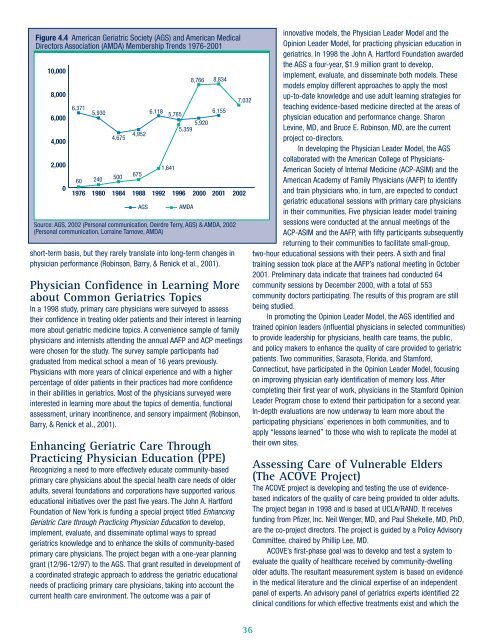Geriatric Medicine Training and Practice in the United States at the ...
Geriatric Medicine Training and Practice in the United States at the ...
Geriatric Medicine Training and Practice in the United States at the ...
You also want an ePaper? Increase the reach of your titles
YUMPU automatically turns print PDFs into web optimized ePapers that Google loves.
Figure 4.4 American <strong>Geri<strong>at</strong>ric</strong> Society (AGS) <strong>and</strong> American Medical<br />
Directors Associ<strong>at</strong>ion (AMDA) Membership Trends 1976-2001<br />
10,000<br />
8,000<br />
6,000<br />
4,000<br />
6,371<br />
5,930<br />
4,675<br />
4,952<br />
2,000<br />
1,641<br />
60 240 500<br />
675<br />
0 1976 1980 1984 1988 1992 1996 2000 2001 2002<br />
short-term basis, but <strong>the</strong>y rarely transl<strong>at</strong>e <strong>in</strong>to long-term changes <strong>in</strong><br />
physician performance (Rob<strong>in</strong>son, Barry, & Renick et al., 2001).<br />
Physician Confidence <strong>in</strong> Learn<strong>in</strong>g More<br />
about Common <strong>Geri<strong>at</strong>ric</strong>s Topics<br />
In a 1998 study, primary care physicians were surveyed to assess<br />
<strong>the</strong>ir confidence <strong>in</strong> tre<strong>at</strong><strong>in</strong>g older p<strong>at</strong>ients <strong>and</strong> <strong>the</strong>ir <strong>in</strong>terest <strong>in</strong> learn<strong>in</strong>g<br />
more about geri<strong>at</strong>ric medic<strong>in</strong>e topics. A convenience sample of family<br />
physicians <strong>and</strong> <strong>in</strong>ternists <strong>at</strong>tend<strong>in</strong>g <strong>the</strong> annual AAFP <strong>and</strong> ACP meet<strong>in</strong>gs<br />
were chosen for <strong>the</strong> study. The survey sample participants had<br />
gradu<strong>at</strong>ed from medical school a mean of 16 years previously.<br />
Physicians with more years of cl<strong>in</strong>ical experience <strong>and</strong> with a higher<br />
percentage of older p<strong>at</strong>ients <strong>in</strong> <strong>the</strong>ir practices had more confidence<br />
<strong>in</strong> <strong>the</strong>ir abilities <strong>in</strong> geri<strong>at</strong>rics. Most of <strong>the</strong> physicians surveyed were<br />
<strong>in</strong>terested <strong>in</strong> learn<strong>in</strong>g more about <strong>the</strong> topics of dementia, functional<br />
assessment, ur<strong>in</strong>ary <strong>in</strong>cont<strong>in</strong>ence, <strong>and</strong> sensory impairment (Rob<strong>in</strong>son,<br />
Barry, & Renick et al., 2001).<br />
Enhanc<strong>in</strong>g <strong>Geri<strong>at</strong>ric</strong> Care Through<br />
Practic<strong>in</strong>g Physician Educ<strong>at</strong>ion (PPE)<br />
Recogniz<strong>in</strong>g a need to more effectively educ<strong>at</strong>e community-based<br />
primary care physicians about <strong>the</strong> special health care needs of older<br />
adults, several found<strong>at</strong>ions <strong>and</strong> corpor<strong>at</strong>ions have supported various<br />
educ<strong>at</strong>ional <strong>in</strong>iti<strong>at</strong>ives over <strong>the</strong> past five years. The John A. Hartford<br />
Found<strong>at</strong>ion of New York is fund<strong>in</strong>g a special project titled Enhanc<strong>in</strong>g<br />
<strong>Geri<strong>at</strong>ric</strong> Care through Practic<strong>in</strong>g Physician Educ<strong>at</strong>ion to develop,<br />
implement, evalu<strong>at</strong>e, <strong>and</strong> dissem<strong>in</strong><strong>at</strong>e optimal ways to spread<br />
geri<strong>at</strong>rics knowledge <strong>and</strong> to enhance <strong>the</strong> skills of community-based<br />
primary care physicians. The project began with a one-year plann<strong>in</strong>g<br />
grant (12/96-12/97) to <strong>the</strong> AGS. Th<strong>at</strong> grant resulted <strong>in</strong> development of<br />
a coord<strong>in</strong><strong>at</strong>ed str<strong>at</strong>egic approach to address <strong>the</strong> geri<strong>at</strong>ric educ<strong>at</strong>ional<br />
needs of practic<strong>in</strong>g primary care physicians, tak<strong>in</strong>g <strong>in</strong>to account <strong>the</strong><br />
current health care environment. The outcome was a pair of<br />
AGS<br />
6,118<br />
AMDA<br />
8,766<br />
8,834<br />
6,155<br />
5,785<br />
5,920<br />
5,359<br />
Source: AGS, 2002 (Personal communic<strong>at</strong>ion, Deirdre Terry, AGS) & AMDA, 2002<br />
(Personal communic<strong>at</strong>ion, Lorra<strong>in</strong>e Tarnove, AMDA)<br />
7,032<br />
<strong>in</strong>nov<strong>at</strong>ive models, <strong>the</strong> Physician Leader Model <strong>and</strong> <strong>the</strong><br />
Op<strong>in</strong>ion Leader Model, for practic<strong>in</strong>g physician educ<strong>at</strong>ion <strong>in</strong><br />
geri<strong>at</strong>rics. In 1998 <strong>the</strong> John A. Hartford Found<strong>at</strong>ion awarded<br />
<strong>the</strong> AGS a four-year, $1.9 million grant to develop,<br />
implement, evalu<strong>at</strong>e, <strong>and</strong> dissem<strong>in</strong><strong>at</strong>e both models. These<br />
models employ different approaches to apply <strong>the</strong> most<br />
up-to-d<strong>at</strong>e knowledge <strong>and</strong> use adult learn<strong>in</strong>g str<strong>at</strong>egies for<br />
teach<strong>in</strong>g evidence-based medic<strong>in</strong>e directed <strong>at</strong> <strong>the</strong> areas of<br />
physician educ<strong>at</strong>ion <strong>and</strong> performance change. Sharon<br />
Lev<strong>in</strong>e, MD, <strong>and</strong> Bruce E. Rob<strong>in</strong>son, MD, are <strong>the</strong> current<br />
project co-directors.<br />
In develop<strong>in</strong>g <strong>the</strong> Physician Leader Model, <strong>the</strong> AGS<br />
collabor<strong>at</strong>ed with <strong>the</strong> American College of Physicians-<br />
American Society of Internal <strong>Medic<strong>in</strong>e</strong> (ACP-ASIM) <strong>and</strong> <strong>the</strong><br />
American Academy of Family Physicians (AAFP) to identify<br />
<strong>and</strong> tra<strong>in</strong> physicians who, <strong>in</strong> turn, are expected to conduct<br />
geri<strong>at</strong>ric educ<strong>at</strong>ional sessions with primary care physicians<br />
<strong>in</strong> <strong>the</strong>ir communities. Five physician leader model tra<strong>in</strong><strong>in</strong>g<br />
sessions were conducted <strong>at</strong> <strong>the</strong> annual meet<strong>in</strong>gs of <strong>the</strong><br />
ACP-ASIM <strong>and</strong> <strong>the</strong> AAFP, with fifty participants subsequently<br />
return<strong>in</strong>g to <strong>the</strong>ir communities to facilit<strong>at</strong>e small-group,<br />
two-hour educ<strong>at</strong>ional sessions with <strong>the</strong>ir peers. A sixth <strong>and</strong> f<strong>in</strong>al<br />
tra<strong>in</strong><strong>in</strong>g session took place <strong>at</strong> <strong>the</strong> AAFP’s n<strong>at</strong>ional meet<strong>in</strong>g <strong>in</strong> October<br />
2001. Prelim<strong>in</strong>ary d<strong>at</strong>a <strong>in</strong>dic<strong>at</strong>e th<strong>at</strong> tra<strong>in</strong>ees had conducted 64<br />
community sessions by December 2000, with a total of 553<br />
community doctors particip<strong>at</strong><strong>in</strong>g. The results of this program are still<br />
be<strong>in</strong>g studied.<br />
In promot<strong>in</strong>g <strong>the</strong> Op<strong>in</strong>ion Leader Model, <strong>the</strong> AGS identified <strong>and</strong><br />
tra<strong>in</strong>ed op<strong>in</strong>ion leaders (<strong>in</strong>fluential physicians <strong>in</strong> selected communities)<br />
to provide leadership for physicians, health care teams, <strong>the</strong> public,<br />
<strong>and</strong> policy makers to enhance <strong>the</strong> quality of care provided to geri<strong>at</strong>ric<br />
p<strong>at</strong>ients. Two communities, Sarasota, Florida, <strong>and</strong> Stamford,<br />
Connecticut, have particip<strong>at</strong>ed <strong>in</strong> <strong>the</strong> Op<strong>in</strong>ion Leader Model, focus<strong>in</strong>g<br />
on improv<strong>in</strong>g physician early identific<strong>at</strong>ion of memory loss. After<br />
complet<strong>in</strong>g <strong>the</strong>ir first year of work, physicians <strong>in</strong> <strong>the</strong> Stamford Op<strong>in</strong>ion<br />
Leader Program chose to extend <strong>the</strong>ir particip<strong>at</strong>ion for a second year.<br />
In-depth evalu<strong>at</strong>ions are now underway to learn more about <strong>the</strong><br />
particip<strong>at</strong><strong>in</strong>g physicians’ experiences <strong>in</strong> both communities, <strong>and</strong> to<br />
apply “lessons learned” to those who wish to replic<strong>at</strong>e <strong>the</strong> model <strong>at</strong><br />
<strong>the</strong>ir own sites.<br />
Assess<strong>in</strong>g Care of Vulnerable Elders<br />
(The ACOVE Project)<br />
The ACOVE project is develop<strong>in</strong>g <strong>and</strong> test<strong>in</strong>g <strong>the</strong> use of evidencebased<br />
<strong>in</strong>dic<strong>at</strong>ors of <strong>the</strong> quality of care be<strong>in</strong>g provided to older adults.<br />
The project began <strong>in</strong> 1998 <strong>and</strong> is based <strong>at</strong> UCLA/RAND. It receives<br />
fund<strong>in</strong>g from Pfizer, Inc. Neil Wenger, MD, <strong>and</strong> Paul Shekelle, MD, PhD,<br />
are <strong>the</strong> co-project directors. The project is guided by a Policy Advisory<br />
Committee, chaired by Phillip Lee, MD.<br />
ACOVE’s first-phase goal was to develop <strong>and</strong> test a system to<br />
evalu<strong>at</strong>e <strong>the</strong> quality of healthcare received by community-dwell<strong>in</strong>g<br />
older adults. The resultant measurement system is based on evidence<br />
<strong>in</strong> <strong>the</strong> medical liter<strong>at</strong>ure <strong>and</strong> <strong>the</strong> cl<strong>in</strong>ical expertise of an <strong>in</strong>dependent<br />
panel of experts. An advisory panel of geri<strong>at</strong>rics experts identified 22<br />
cl<strong>in</strong>ical conditions for which effective tre<strong>at</strong>ments exist <strong>and</strong> which <strong>the</strong><br />
36

















